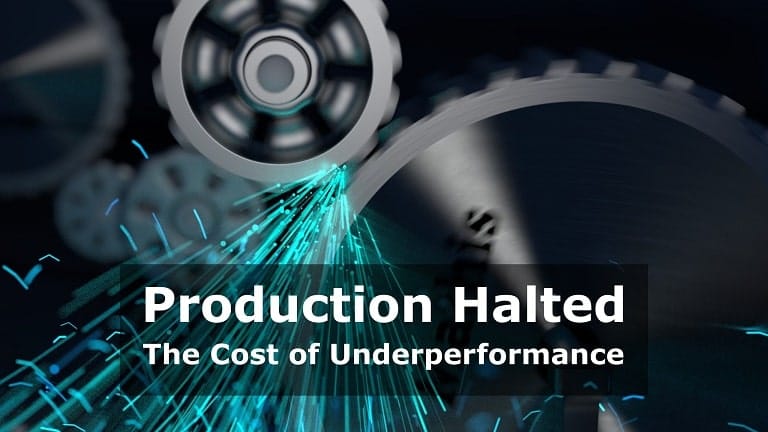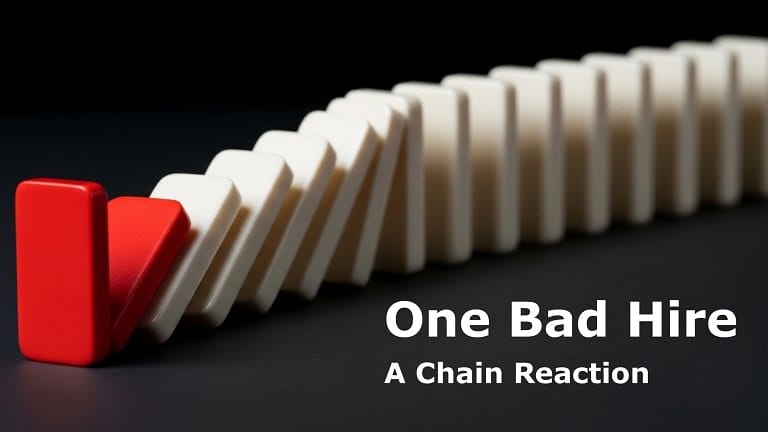Hiring the wrong person in a manufacturing role can feel like a temporary setback—but in reality, it’s often a costly mistake with far-reaching consequences. While many companies focus only on salary when assessing the impact of a bad hire, the true cost runs much deeper. From lost productivity and team disruption to customer dissatisfaction and increased safety risks, one underperforming employee can negatively affect every aspect of your operation.
In this article, we’ll uncover the hidden costs of a bad manufacturing hire, provide a simple framework to estimate those losses, and contrast them with the exceptional ROI of a top-performing employee. By the end, you’ll understand why the right talent isn’t just an asset—it’s a competitive advantage. More importantly, you’ll see how strategic hiring through expert partners like JRG Partners can save you money, improve outcomes, and fuel long-term success.
Why the Cost of a Bad Manufacturing Hire Goes Beyond Salary
When companies evaluate the financial impact of a bad manufacturing hire, they often look at salary as the main expense. However, salary is just the tip of the iceberg. The true cost extends far beyond compensation and can affect almost every aspect of a production facility’s operations.
Here’s a closer look at the hidden costs that often go unnoticed:
- Wasted Training Time: Time spent onboarding and training a hire who doesn’t work out is time lost. Supervisors, HR staff, and experienced employees all contribute hours that can’t be recovered.
- Productivity Slowdowns: A bad hire can slow down production lines, miss shift quotas, or require constant oversight, affecting the entire team’s output.
- Process Errors & Safety Risks: In manufacturing, even small mistakes can lead to damaged equipment or serious safety hazards. In regulated environments, errors may lead to fines, audits, or compliance issues.
- Equipment Misuse: Unqualified hires may misuse tools or machinery, resulting in increased wear-and-tear or expensive repairs.
- Impact on Team Morale: Frustration builds when co-workers have to compensate for someone else’s poor performance. This leads to disengagement or worse attrition among top performers.
- Customer Dissatisfaction: Quality issues or missed deadlines caused by an underperforming hire can lead to order cancellations, returns, and damaged client relationships.
These hidden costs quickly multiply, often exceeding 2–3x the employee’s annual salary.
Pro Tip: In precision-driven industries like manufacturing, one wrong hire can ripple across multiple shifts, affecting operations for weeks.
To avoid this snowball effect, manufacturers must go beyond resumes and assess candidates for skill, fit, and reliability—factors that are critical on the production floor.
Hidden Costs of a Bad Manufacturing Hire — A Breakdown
According to the U.S. Department of Labor, a bad hire can cost a company up to 30% of that employee’s annual salary. Hiring the wrong person in a manufacturing environment goes far beyond a simple mismatch—it triggers a ripple effect that impacts output, morale, safety, and the bottom line. Below is a detailed breakdown of the hidden costs companies face when a bad hire slips through the cracks.
1. Lost Productivity

One of the most immediate and measurable impacts of a bad hire is lost productivity. Manufacturing operations thrive on efficiency and consistency. When an employee lacks the necessary skills, discipline, or aptitude, it slows down entire processes:
- Frequent Mistakes & Rework: A poor hire may repeatedly make errors that require rework, delaying output and diverting resources to fix problems instead of advancing production.
- Lower Throughput: Whether it’s on an assembly line or in a skilled trade position, underperformance affects units produced per hour, shifts behind schedule, and extended delivery timelines.
- Increased Supervision: Managers and team leads often have to spend more time correcting and overseeing a bad hire’s work, pulling their focus from more strategic or productive tasks.
- Ripple Effect Across Shifts: Since manufacturing often works on shift cycles, one person’s errors can delay or disrupt subsequent shifts, causing cumulative downtime.
In high-volume environments, these issues can equate to thousands—or even millions—of dollars in lost output annually.
2. Team Morale & Culture Damage

The impact of a bad hire isn’t just technical—it’s also psychological. Manufacturing teams often work in close coordination, and when one team member underperforms or behaves poorly, the culture suffers.
- Resentment Builds: Co-workers who need to pick up the slack or redo poor-quality work can quickly become frustrated or demotivated.
- Decreased Trust in Management: When workers see that leadership allows unqualified individuals to stay in critical roles, it can lead to disillusionment and disengagement.
- Increased Turnover: Top-performing employees who feel unsupported or overburdened may choose to leave. This compounds hiring costs and drains institutional knowledge.
A poor cultural fit can slowly erode team cohesion, productivity, and long-term retention.
3. Replacement & Retraining Expenses
Once it’s clear the hire isn’t working out, there’s an entirely new cost layer: replacing and retraining.
- Recruitment & Onboarding: Re-advertising the role, screening resumes, interviewing candidates, and onboarding a new hire require time and resources, often repeating the same cycle.
- Wasted Training Time: Any time invested in training the wrong hire—by mentors, team leaders, or HR—represents a sunk cost.
- Disruption to Training Systems: Replacing a team member midstream interrupts standardized training programs, creates gaps in teams, and may lead to inconsistent knowledge transfer.
- Hidden Time Cost for Supervisors: Every hour a manager spends coaching or correcting a bad hire is an hour taken away from leading, planning, and optimizing operations.
Collectively, these costs can double or triple the expense of the original hire.
4. Customer Experience & Quality Control Issues
In manufacturing, consistency and reliability are the keys to customer satisfaction. A bad hire can directly influence product quality, timeliness, and client confidence.
- Defective Products: A single unskilled worker on the line can compromise entire batches, leading to increased returns, waste, or warranty claims.
- Missed Deadlines: Late production due to slow performance or errors can cascade into missed delivery schedules, especially damaging in B2B environments with tight SLAs.
- Customer Complaints: Poor-quality products or delays may result in client complaints, reduced orders, or even contract termination.
- Brand Damage: Word of mouth in industrial sectors is powerful. Consistent errors can lead to a damaged reputation in your niche or region.
In severe cases, this impact can last well beyond the tenure of the bad hire, affecting client relationships and long-term revenue.
How to Calculate the Real Cost of a Bad Hire (Simple Framework)
Understanding the real cost of a bad manufacturing hire requires looking beyond salary alone. A structured approach helps quantify the hidden expenses and illustrates how quickly the numbers add up. Here’s a simple yet effective framework to calculate this cost.
Bad Hire Cost Formula:
Total Cost = (Salary + Recruitment + Training) + (Lost Productivity + Team Disruption + Customer Loss)
This formula helps break down the full financial impact into two key categories:
- Upfront Costs:
- Salary: The employee’s annual compensation.
- Recruitment: Job ads, recruiter fees, interview time.
- Training: Onboarding materials, trainer hours, and productivity lost during ramp-up.
- Downstream Costs:
- Lost Productivity: Delays, rework, and inefficiency on the shop floor.
- Team Disruption: Supervision time, morale loss, and potential turnover.
- Customer Loss: Defects, missed deadlines, returns, and contract risk.
Sample Scenario:
Let’s say you hire an entry-level manufacturing employee at $45,000/year:
- Recruitment & onboarding: $5,000
- Training & supervisor time: $7,000
- Lost productivity (3–6 months): $20,000
- Team disruption: $10,000
- Customer issues/returns: $15,000
Total Estimated Cost = $102,000+
Pro Tip:
Offer a free downloadable worksheet or calculator on your site so hiring managers can plug in their own numbers and see the hidden cost for themselves.
When you add it all up, a single bad hire can cost 2x–3x their salary—making strategic hiring not just important, but essential.
The ROI of a Great Manufacturing Hire

While bad hires can drain resources and damage team morale, great hires deliver exponential value—not just in performance but in long-term organizational growth. In a high-pressure, precision-driven environment like manufacturing, a top-performing employee does far more than just meet job requirements—they enhance productivity, improve safety, and strengthen team culture.
Here’s how top manufacturing hires generate a strong return on investment (ROI):
1. Increased Efficiency
- Top talent completes tasks faster and with fewer errors.
- They reduce waste and downtime by adhering strictly to SOPs and suggesting process improvements.
- A single high performer can often outproduce 2–3 average employees, according to industry studies.
2. Reduced Overtime and Error Costs
- With better output comes reduced dependency on overtime or rework.
- Fewer errors translate into fewer quality control issues, which saves time and money on reinspection or rework.
3. Innovation and SOP Improvements
- Great hires often propose smarter ways of working—tweaking SOPs, rearranging workflows, or identifying small improvements that have a big impact over time.
- These continuous improvements compound into significant gains in operational efficiency.
4. Improved Morale and Retention
- A productive and positive team member uplifts those around them.
- Teams led or influenced by top performers often experience lower turnover rates, reduced conflict, and stronger peer engagement.
Insight: “A top hire doesn’t just fill a seat—they fuel operational excellence.”
Hiring right the first time isn’t just about filling roles—it’s about unlocking potential. A great manufacturing hire can deliver ROI many times over their cost, making the case for investing in professional talent acquisition through experts like JRG Partners.
How JRG Partners Helps You Avoid the Cost of a Bad Hire
At JRG Partners, we understand the high stakes of hiring in the manufacturing sector. One misstep can disrupt your production line, lower team morale, and impact client satisfaction. That’s why our approach goes beyond resumes—we deliver strategic talent solutions that align with your business goals, operational demands, and cultural fit.
Proven Vetting & Placement Process
Our 5-step executive search methodology ensures that only high-performing, pre-qualified candidates reach your shortlist:
- Deep Discovery: We take time to understand your company’s structure, goals, challenges, and team dynamics.
- Targeted Sourcing: Using our proprietary database and industry networks, we source professionals with a proven track record in manufacturing.
- Behavioral & Technical Screening: Every candidate is rigorously screened for both hard skills (equipment, process, safety) and soft skills (adaptability, teamwork, leadership).
- Culture Fit Assessment: We match candidates based on your values, leadership style, and environment to ensure long-term retention.
- Post-Placement Support: Once placed, we follow up to ensure smooth integration and early-stage performance success.
Specialized Expertise in Manufacturing
We have a long-standing track record across sectors such as:
- Automotive and Aerospace Manufacturing
- Food & Beverage Processing
- Precision Engineering
- Heavy Industrial and Machinery
Our recruiters understand shift structures, regulatory requirements, and lean manufacturing principles, ensuring you get talent that’s ready to perform on day one.
Client Success Story
“Thanks to JRG Partners, we avoided a costly hiring mistake. Their candidate helped increase line efficiency by 22% in just 3 months.”
— Plant Director, Midwestern Manufacturing Company
Conclusion
The cost of a bad hire in manufacturing goes far beyond salary—it affects productivity, team morale, quality control, and customer satisfaction. These hidden costs can quietly erode your bottom line, making every hiring decision critical to operational success. On the other hand, a high-performing employee can deliver exceptional ROI, driving efficiency, innovation, and long-term value.
To avoid these costly mistakes, you need a partner who understands the unique demands of manufacturing environments. JRG Partners specializes in placing top-tier talent in manufacturing leadership and operational roles. We help you hire right the first time—saving time, resources, and costly setbacks.
Learn more about our proven hiring solutions on our Manufacturing Executive Recruiters page.


